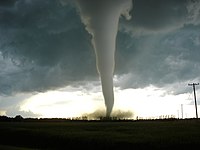
Photo from wikipedia
Abstract The combined actions of climatic variations and landscape barriers shape the history of natural populations. When organisms follow their shifting niches, obstacles in the landscape can lead to the… Click to show full abstract
Abstract The combined actions of climatic variations and landscape barriers shape the history of natural populations. When organisms follow their shifting niches, obstacles in the landscape can lead to the splitting of populations, on which evolution will then act independently. When two such populations are reunited, secondary contact occurs in a broad range of admixture patterns, from narrow hybrid zones to the complete dissolution of lineages. A previous study suggested that barn owls colonized the Western Palearctic after the last glaciation in a ring-like fashion around the Mediterranean Sea, and conjectured an admixture zone in the Balkans. Here, we take advantage of whole-genome sequences of 94 individuals across the Western Palearctic to reveal the complex history of the species in the region using observational and modeling approaches. Even though our results confirm that two distinct lineages colonized the region, one in Europe and one in the Levant, they suggest that it predates the last glaciation and identify a secondary contact zone between the two in Anatolia. We also show that barn owls recolonized Europe after the glaciation from two distinct glacial refugia: a previously identified western one in Iberia and a new eastern one in Italy. Both glacial lineages now communicate via eastern Europe, in a wide and permeable contact zone. This complex history of populations enlightens the taxonomy of Tyto alba in the region, highlights the key role played by mountain ranges and large water bodies as barriers and illustrates the power of population genomics in uncovering intricate demographic patterns.
Journal Title: Molecular Biology and Evolution
Year Published: 2021
Link to full text (if available)
Share on Social Media: Sign Up to like & get
recommendations!